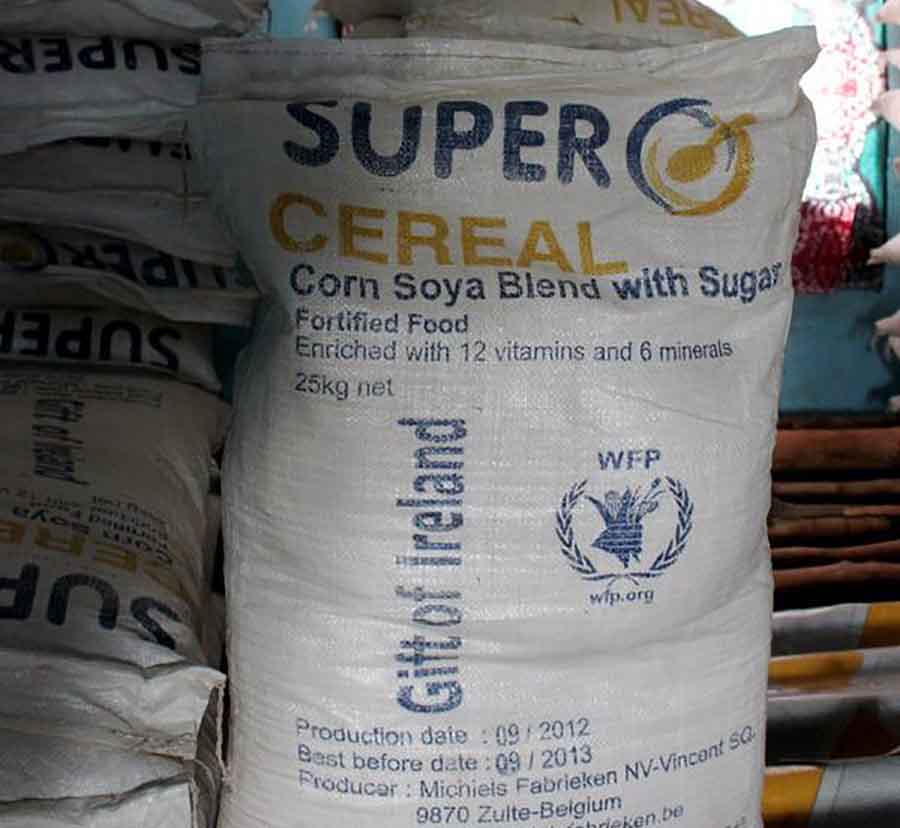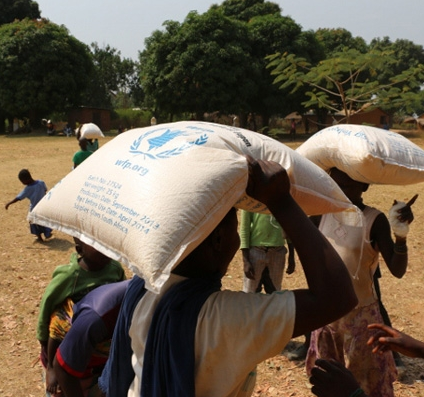SUPER CEREAL, rice soya, fortified flour, 25kg
Valid Article
SUPER CEREAL
CAUTION
Those articles are non-standard as international procurement is difficult. They are usually locally supplied by WFP via donation.
Definition
Pre-cooked Fortified Flour (PFF) used for general (WFP) and family rations distributions, as well as in supplementary feeding programmes and in blanket feeding programmes.
Synonym
The new term used by WFP, SUPER CEREAL, replaces precooked fortified flour with milk (CSB+).
Specifications
Precooked Fortified Flours are made from a blend of corn (or wheat or rice) and soya flours, enriched with a complex of vitamins and minerals [CMV premix].
Examples: CSB+ (Corn Soya Blend)(WFP-MSF), WSB (Wheat Soya Blend)(WFP).
Precooked fortified flours may vary in terms of:
- corn soya ratio (or wheat/soya or rice/soya) (Unimix: 80% maize and 20% soya)
- the presence of sugar is possible for CSB+
- vitamin and mineral content
These flours must be partially cooked according to the international standard CODEX STAN 74-1981, to obtain a digestible porridge after a short cooking time, or even without cooking.
Maize must undergo an hydrothermal treatment to achieve a high level of starch gelatinisation.
Soya must undergo a treatment permitting to inactivate anti-nutritional factors (mainly antitrypsin).
Cooking-extrusion is the best cooking process for obtaining an energy-dense porridge.
Other cooking processes, such as micronisation (UV roasting) can be used, but the initial validation analysis carried out by the supplier must demonstrate the capacity of the process to fully gelatinise the starch and inactivate antitrypsin factors.
Technical specifications
These flours must be precooked at 80-90% (precooking is tested by amyloglucosidase digestion, or indirect methods like Differential Scanning Calorimetry [DSC] or Rapid Viscosity Analysis [RVA]).
| Nutritional value | per 100 g (min - max) |
| Energy (kcal) | > 370 |
| Proteins (g) | 13 - 16 |
| Lipids (g) | > 5.5 |
| Fibres (g) | < 5 |
| Minerals | per 100 g (min - max) |
| Calcium (Ca) (mg) | 130 - 325 |
| Iron (fFe) (mg) | > 6.5 |
| Zinc (Zn) (mg) | 11 - 15 |
| Copper (Cu) (mg | 0.6 - 0.9 |
| Iodine (I) (mg) | 585 - 812 |
| Vitamins | per 100 g (min - max) |
| Retinol (Vit A) (IU) | 1660 - 2900 |
| Cholecalciferol (Vit D) (IU) | 150 - 250 |
| Tocopherol (Vit E) (IU) | 6.75 - 9.4 |
| Ascorbic ac. (Vit C) (mg) | > 54 |
| Thiamin (Vit B1) (mg) | 0.13 - 0.35 |
| Riboflavin (Vit B2) (mg) | 0.44 - 1.0 |
| Niacin (Vit B3) (mg) | 4.5 - 6.25 |
| Pyridoxine (Vit B6) (mg) | 0.148 - 0.206 |
| Cobalamin (Vit B12) (µg) | 1.1 - 2.0 |
| Folic acid (Vit B9) (µg) | 60 - 250 |
| Pantothenic acid (Vit B5) (mg) | 2.5 - 6.7 |
Physical and organoleptic specifications
- Energy Density (as a porridge to be eaten with a spoon): 100 Kcal per 100 ml
- Texture:
- Dispensability: free from lumping or balling when mixed with water at room temperature
- Particle size: uniform fine texture with the following particle distribution:
- 95% shall pass through a 600 micrometer sieve
- 100% shall pass through a 1000 micrometer sieve
- Consistency/Viscosity of porridge: Bostwick test: min 55 / max 110 mm per 30 sec at 45°C and at the proposed preparation dosage (20g of product plus 150g water after cooking at simmering point for five minutes)
- Anti-nutrients: urease index between 0.01 & 0.2 pH units.
- Organoleptic:
- Smell: pleasant (not rancid, not dusty, not musty)
- Taste: tasty (not bitter, not acidic, not off-flavour)
- Colour: clear, not dark / brown
- Foreign matter: free from foreign matter and insects
- Cooking time at simmering point: 5 minutes minimum and 10 minutes maximum
- Peroxide value: max 10 meq/kg fat
Packaging & Labelling
Primary and secondary packaging must protect the hygienic and nutritional qualities of the product during transport, handling, storage under MSF field conditions.
- Net weight: 25 kg
- Outer bag: new woven polypropylene (PP) bags with double stitching
- Inner bag: low density polyethylene (LDPE), heat sealed on top and bottom
The following must appear on the packaging:
- name of the product
- net weight
- batch number
- date of manufacture
- expiry date
- composition of the product
- country of origin
- name and address of the manufacturer
Instructions for use
In supplementary feeding programmes, vegetable oil should be added to increase the energy content.
Sugar can also be added to improve taste.
Storage
- Keep in a well-ventilated place below 40°C, Protect from humidity
- Shelf life: between 6 and 12 months. It mainly depends on the CMV added to the product.
- Precooked fortified flours (PFF) are much more sensitive to microbiological and insect attacks than the basic ingredients in grain. The moisture content should not exceed 11%. Above 14.5% moisture, there is an immediate development of toxins if the temperature exceeds 25ºC.
- Storage volume: 1.6 to 1.9 m3/MT
- Storage surface: 0.4 to 0.5m2/MT
Main risks
- Insect infestation. Good storage practices and regular controls prevent infestation. Treatment is needed as soon as the first signs of infestation are detected.
- Growth of mycotoxin-secreting fungi, due to increased moisture content > 14%
Follow the procedure QA-NFOS-SOP3 Storage of specialised food (NFOS)
For procedures related to Quality Control, refer to Preliminary remarks on specialised food





![[NSFSCRECOSE] CHECKLIST CONTROL UPON RECEIPT specialised food, English](/web/image/product.template/572035/image_256/%5BNSFSCRECOSE%5D%20CHECKLIST%20CONTROL%20UPON%20RECEIPT%20specialised%20food%2C%20English?unique=af6e3c6)
![[NSFSCRECOSF] CHECKLIST CONTROL UPON RECEIPT specialised food, French](/web/image/product.template/572046/image_256/%5BNSFSCRECOSF%5D%20CHECKLIST%20CONTROL%20UPON%20RECEIPT%20specialised%20food%2C%20French?unique=af6e3c6)
![[NSFSQCONFFE] CHECKLIST FOR SUPER CEREAL QUALITY CONTROL Engl](/web/image/product.template/569696/image_256/%5BNSFSQCONFFE%5D%20CHECKLIST%20FOR%20SUPER%20CEREAL%20QUALITY%20CONTROL%20Engl?unique=3665ce3)
![[NSFSQCONFFF] CHECKLIST FOR SUPER CEREAL QUALITY CONTROL Fr.](/web/image/product.template/569695/image_256/%5BNSFSQCONFFF%5D%20CHECKLIST%20FOR%20SUPER%20CEREAL%20QUALITY%20CONTROL%20Fr.?unique=bd52ba7)